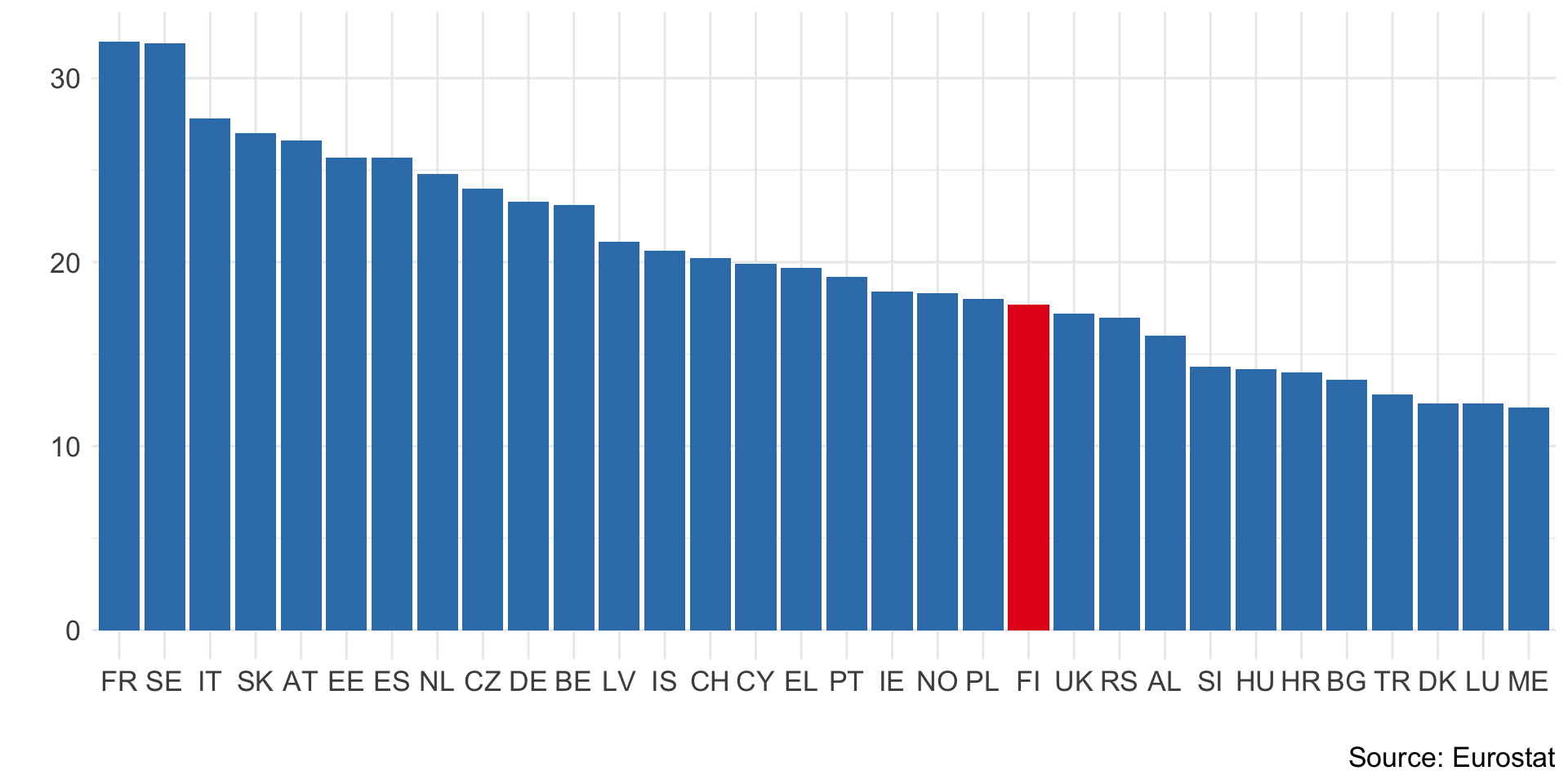
3. Labour Demand
KAT.TAL.322 Advanced Course in Labour Economics
Labour demand
Firm decisions about how much labour to hire.
Organizational bits:
- Form groups on Moodle (demonstration)
- Group membership according to prior agreement with everyone in the group
Static model
Static model
Single factor input
Production function \(Y = F(L)\) where \(F^\prime > 0\) and \(F^{\prime\prime} < 0\)
\[ \max_{L} PF(L) - WL \]
FOC: \(F^\prime(L) = \frac{W}{P}\)
Downward-sloping labour demand \(\frac{\partial L}{\partial W} = \frac{1}{PF^{\prime\prime}(L)} < 0\)
See Cahuc (2004) chapter 2 for similar non-competitive firm problem
Labour is the only production input
Increasing and concave production function
Price-taking firm
Knowing functional form of \(F(\cdot)\) gives as labour demand function
Labour only \(\approx\) short run (+ capital \(\approx\) long run)
Static model
Two factor inputs: conditional factor demand
Cost minimization problem
\(\min_{L, K} C(L, K) = WL + RK\) s.t. \(F(L, K) = \bar{Y}\)
Conditional demand functions \(\bar{K}(W, R, Y)\) and \(\bar{L}(W, R, Y)\)
\[ \frac{F_L(\bar{L}, \bar{K})}{F_K(\bar{L}, \bar{K})} = \frac{W}{R} \quad\text{and}\quad F(\bar{L}, \bar{K}) = \bar{Y} \]
\(\frac{F_L(L, K)}{F_K(L, K)}\) is technical rate of substitution between capital and labour
Draw the isoquant and isocost curves
Static model
Two factor inputs: conditional demand elasticities
Own-price elasticities: \(\eta_W^L = \frac{\partial \ln \bar{L}}{\partial \ln W} < 0\), \(\eta_R^K = \frac{\partial \ln \bar{K}}{\partial \ln R} < 0\)
Cross-price elasticities: \(\eta_R^L = \frac{\partial \ln \bar{L}}{\partial \ln R} > 0\) and \(\eta_W^K = \frac{\partial \ln \bar{K}}{\partial \ln W} > 0\)
Elasticity of substitution \(\sigma = \frac{\partial \ln\left(\frac{K}{L}\right)}{\partial \ln \left(\frac{W}{R}\right)} > 0\)
It is also possible to show that
\[ \eta_R^L = \sigma (1 - s) \quad \text{and} \quad \eta_W^L = -\sigma(1 - s) \]
where \(s = \frac{WL}{C}\) is labour share in total cost
Derivations in Cahuc (2004) chapter 2
Own-price elasticities always negative again due to concavity of the production function (intuitive)
Cross-price elasticities are positive: with output fixed, if one factor is more expensive, substitute to the cheaper factor to offset.
- Also intuitive, BUT do not tell to what extent substitution makes sense
Therefore, elasticity of substitution
The sign is determined by the properties of cost function => direct to more detailed discussion in Cahuc (2004)
The positive sign in a sense is similar to cross-price intuition.
The factor share expressions
useful empirically
alternative (easy) reasoning
Static model
Two factor inputs: unconditional factor demand
\(\max_{Y} PY - C(W, R, Y)\)
Solution: \(P = C_Y(W, R, Y^*), L^* = \bar{L}(W, R, Y^*), K^* = \bar{K}(W, R, Y^*)\)
Total elasticities decomposed into substitution and scale effects:
\[ \varepsilon_W^L = \color{#8e2f1f}{\eta_W^L} + \color{#288393}{\eta_Y^L \varepsilon_W^Y} < 0 \]
\[ \varepsilon_R^L = \color{#8e2f1f}{\eta_R^L} + \color{#288393}{\eta_Y^L\varepsilon_R^Y} \lessgtr 0 \]
Similar conclusions in models with >2 inputs (Cahuc 2004, chap. 2, section 1.4)
Now that we know minimum cost for every level of \(Y\), only find \(Y\) that maximizes profit
\(Y^\star\) given by first FOC \(\Rightarrow\) \(K^\star\) and \(L^\star\) found by plugging \(Y^\star\) to conditinal demands
Now, can talk about total elasticity, substituion and scale.
Encourage to go through derivations on their own!
Own-price total elasticity (walk-through):
conditional elasticity \(\eta_W^L < 0\)
scale: \(\uparrow W \Rightarrow \downarrow Y \Rightarrow \downarrow L\) (homogeneous production function)
Cross-price total elasticity:
do not walk through!
gross complements \(\varepsilon_R^L < 0\) or gross substitutes \(\varepsilon_R^L > 0\)
\[ \begin{align*} \frac{\partial L^*}{\partial W} &= C_{WW} + C_{WY} \frac{\partial Y^*}{\partial W} = \\ &= C_{WW} + C_{WY} \left(-\frac{-C_{WY}}{-C_{YY}}\right) = \\ &= C_{WW} + \frac{C_{WY}^2}{-C_{YY}} \end{align*} \]
The sign of scale effect is then determined by the sign of \(-C_{YY}\). A necessary condition for profit function to have a maximum is SOC < 0 \(\Rightarrow -C_{YY} < 0 \Rightarrow\) scale effect is negative.
\[ \begin{align*} \frac{\partial L^*}{\partial R} &= C_{WR} + C_{WY} \frac{\partial Y^*}{\partial R} = \\ &= C_{WR} + C_{WY} \left(-\frac{-C_{RY}}{-C_{YY}}\right) = \\ &= C_{WR} + \frac{C_{WY} C_{RY}}{-C_{YY}} \end{align*} \]
Here the sign of the scale effect depends on signs of \(C_{WY}\) and \(C_{RY}\) which really depends on the production function.
Estimations of static model
Empirical strategy
Shephard’s lemma: specify cost function and back out labour demand
Example: translog cost function with \(n\) inputs
\[ \ln C = a_0 + \sum_{i = 1}^n a_i \ln W^i + \frac{1}{2} \sum_{i = 1}^n \sum_{j = 1}^n a_{ij} \ln W^i \ln W^j + \frac{1}{\theta} \ln Y \]
\[ \Rightarrow s^i = a_i + \sum_{j = 1}^n a_{ij} \ln W^j \]
Estimate parameters \(a_{i}, a_{ij}\) and calculate implied elasticities.
Shephard’s lemma: \(\bar{L} = \frac{\partial C}{\partial W}\) (keep \(Y\) fixed)
\[ L^i = \frac{\partial C}{\partial W^i} \Rightarrow \frac{W^i L^i}{C} = \frac{W^i}{C}\frac{\partial C}{\partial W^i} = W^i \frac{\partial \ln C}{\partial W^i} \]
Can get data about \(s^i\) and \(W^i\) directly \(\Rightarrow\) estimate the share equation
Estimations of static model
Main issues
Endogeneity
General equilibrium
Definitions of variables
Endogeneity:
most productive firms hire more people and pay higher wages (cross-section)
common shock that changes wages and employment, like trade shock (time-series)
Definition:
how to measure labour: number of people, people hours, quality of labour
wages: what about nonwage benefits that matter for firm decisions?
Estimations of static model
Review by Hamermesh (1996) concludes that \(-\eta_W^L \in [0.15, 0.75]\).
If \(\eta_W^L = -0.30\) and given that \(s \approx 0.7\),
\[ \sigma = \frac{-\eta_W^L}{1 - s} \approx 1 \]
consistent with the Cobb-Douglas production function.
The review also suggests \(-\varepsilon_W^L \approx 1 \Rightarrow\) large scale effect.
Dynamic model
Dynamic model
Adjustment costs
Quadratic cost: \(C\left(\Delta L_t\right) = b\left(\Delta L_t - a\right)^2\)
Assymmetric convex costs: \(C\left(\Delta L_t\right) = -1 + e^{a\Delta L_t} - a\Delta L_t + \frac{b}{2}\left(\Delta L_t\right)^2\)
Linear cost: \(C\left(\Delta L_t\right) = \begin{cases}c_h \Delta L_t & \text{if }\Delta L_t \geq 0\\-c_f \Delta L_t & \text{if }\Delta L_t \leq 0\end{cases}\)
Fixed cost
Examples of “adjustment” costs:
First ask them!
costs associated with hiring/firing, maybe even promoting people
but also nonwage benefits, such as extra healthcare insurance or lunch programs
Dynamic model
Quadratic adjustment cost
Continuous time \(\Rightarrow \Delta L_t = \dot{L}_t = \frac{\text{d} L_t}{\text{d}t}\)
\[ \Pi_0 = \int_0^\infty \Pi_t dt = \int_0^\infty \left[F(L_t) - W_tL_t - \frac{b}{2}\dot{L}_t^2\right]e^{-rt}dt \]
Euler equation: \(\frac{\partial \Pi_t}{\partial L} = \frac{\text{d}}{\text{d}t}\left(\frac{\partial \Pi_t}{\partial \dot{L}_t}\right) \Rightarrow b\ddot{L}_t - rb\dot{L}_t + F'(L_t) - W_t = 0\)
Walk-through the derivation steps!
Euler condition derived in Cahuc (2004) (general result, take as given here)
\[ \frac{\partial \Pi_t}{\partial L_t} = \left(F^\prime(L_t) - W_t\right)e^{-rt} \]
\[ \frac{\partial \Pi_t}{\partial \dot{L}_t} = -b \dot{L}_t e^{-rt} \]
\[ \frac{\partial }{\partial t}\left(\frac{\partial \Pi_t}{\partial \dot{L}_t}\right) = -b\ddot{L}_t e^{-rt} + b\dot{L}_t e^{-rt} r \]
Therefore, plugging into Euler equation we get
\[ \left(F^\prime(L_t) - W_t + b \ddot{L}_t - rb \dot{L}_t\right)e^{-rt} = 0 \]
Hence, the optimality condition on the slide.
- Stationary solution \(\dot{L}_t = \ddot{L}_t = 0 \Rightarrow F'(L_t) = W_t\)
- Inadequate if \(\dot{L}_t = 0\) achieved by hiring exactly offsetting firing
Dynamic model
Quadratic adjustment cost
Optimal path: \(\dot{L}_t = \gamma \left[L^* - L_t\right]\) where \(\gamma\) is decreasing in \(b\).
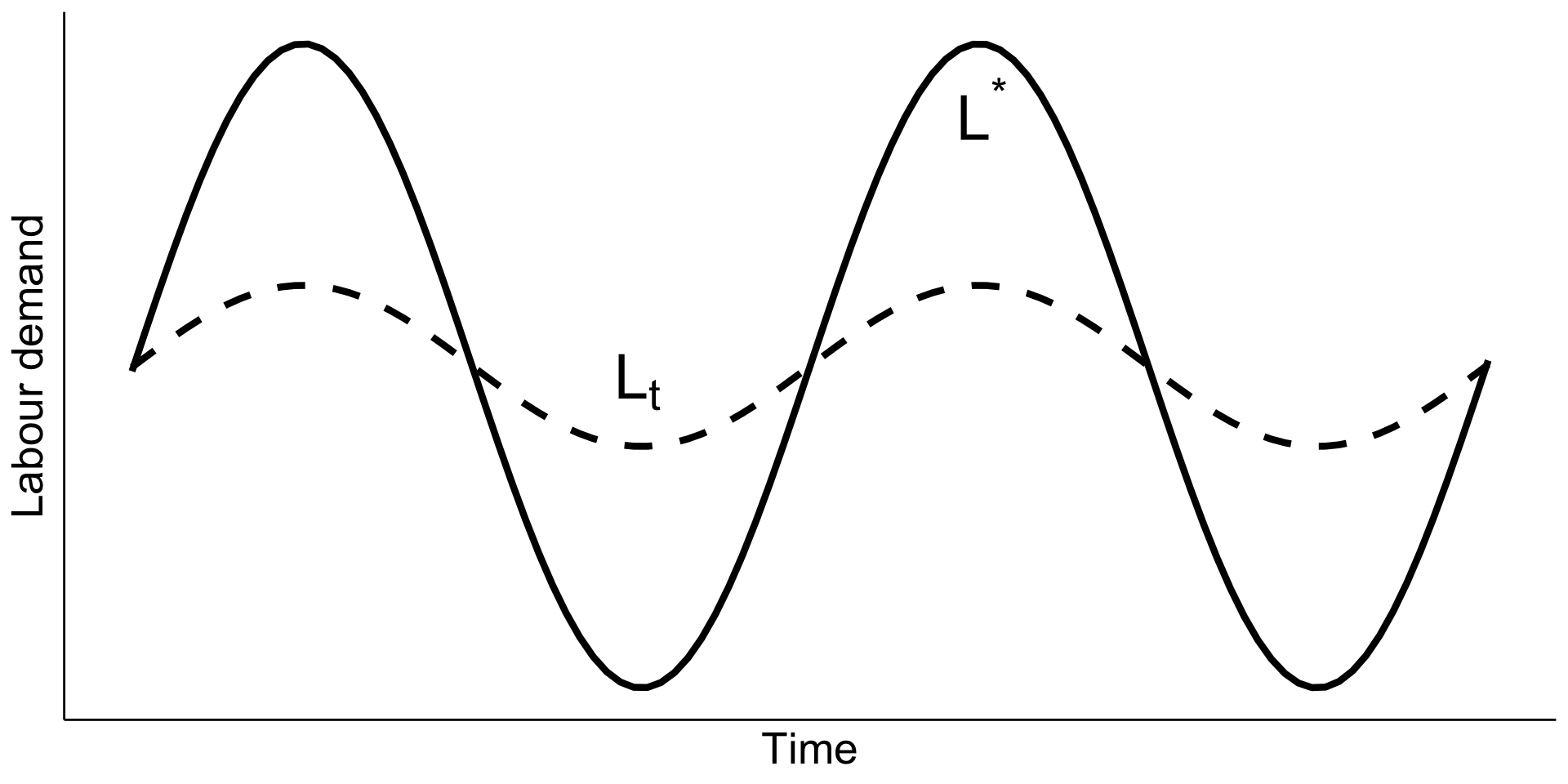
The theory was derived to analyse labour demand over the business cycle => \(L^\star\) follows the business cycle
Highlight the smoothing!
do not fire as much during recession because foresse hiring in the boom
vice versa
BUT
data suggests adjustments happen more quickly (maybe just means that \(b\) smaller)
symmetry forced by construction!
Dynamic model
Linear adjustment cost
\[ \Pi_0 = \int_0^\infty \left[F(L_t) - W_tL_t - C(\dot{L}_t)\right]e^{-rt}dt \]
where \(C\left(\dot{L}_t\right) = \begin{cases}c_h \dot{L}_t & \text{if }\dot{L}_t \geq 0\\-c_f \dot{L}_t & \text{if }\dot{L}_t \leq 0\end{cases}\)
Optimal labour demand path is derived from
\[ \begin{cases}F'(L_t) = W_t + r c_h & \text{if }\dot{L}_t \geq 0 \\ F'(L_t) = W_t - r c_f & \text{if }\dot{L}_t < 0\end{cases} \]
Nothing happens if \(F'(L_t) \in \left[W_t - rc_f, W_t + rc_h\right]\)
No smoothing: demand immediately jumps to stationary value if marginal productivities outweigh the costs
Allows to analyse changes in hiring and firing costs separately
Dynamic model
Linear adjustment cost
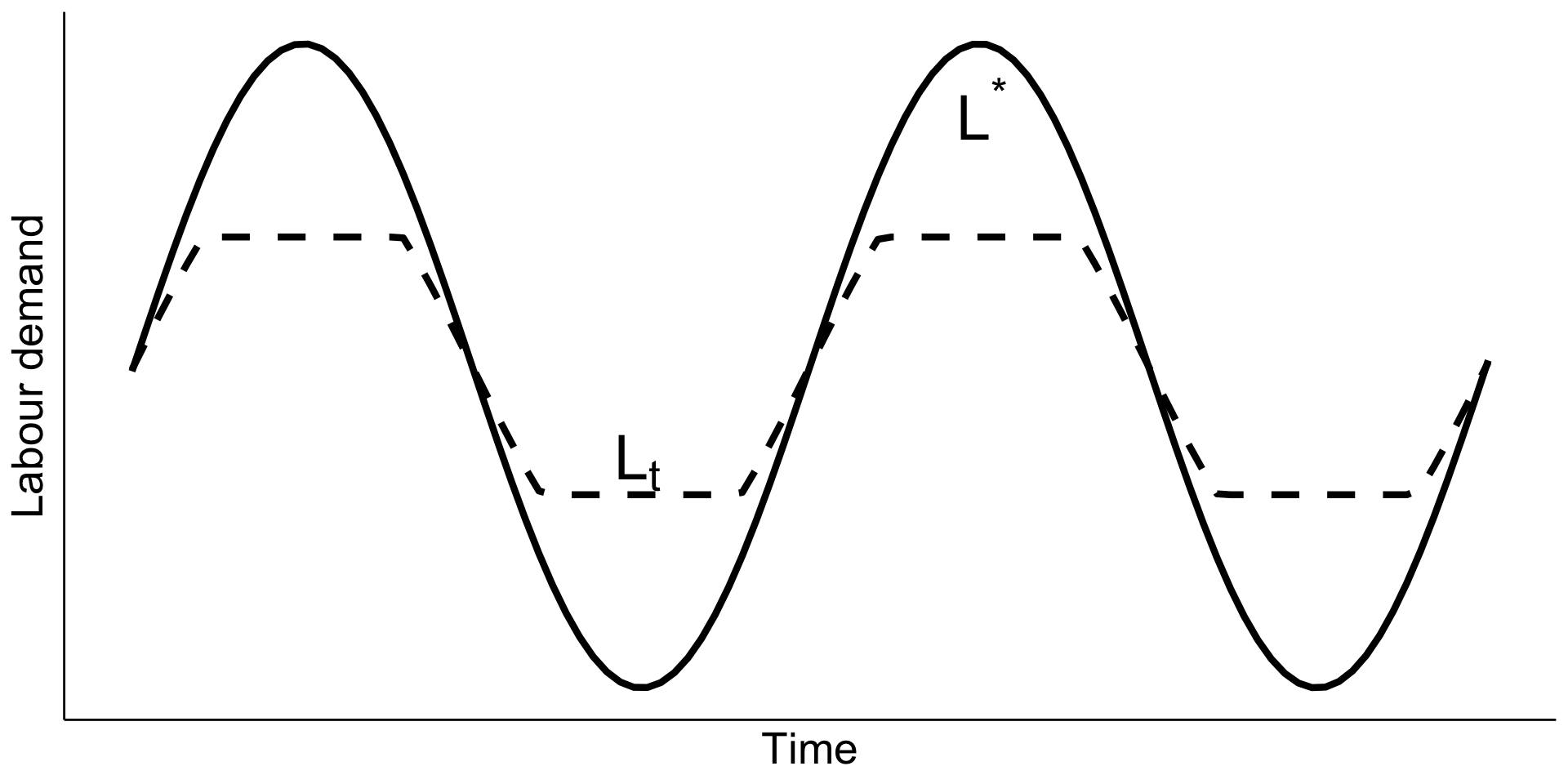
There are two levels of optimal labour supply \(L_h\) in the hiring phase and \(L_f\) in the firing phase
When things change, the firm immediately jumps to the new optimum if the deviation is large enough
The levels \(L_h\) and \(L_f\) depend on the adjustment costs and need not be symmetric
Estimations of dynamic model
Empirical strategy for adjustment cost specification
Quadratic adjustment cost
Assume linear quadratic production function
Estimate \(L_{it} = \lambda L_{i, t - 1} + X_{it} \beta + \mu_i + \varepsilon_{it}\)
- accounting for correlation between \(L_{i, t - 1}\) and \(\mu_i + \varepsilon_{it}\)
Other adjustment costs and production functions
Estimate Euler equation directly
Current employment \(L_t\) depends on past and future variables
Appropriate econometric methods (Hamilton 1994 book)
Mention uncertainty necessary to get estimable equation from models!
Highlight the simple panel regression depends on functional assumptions for both \(C\) and \(F\)!
Estimations of dynamic model
Some key results
Adjustments happen fast (1-2 quarters) (Hamermesh 1996, chap. 7)
Dynamic substitutes: utilization of capital increases with \(L_t - L^*\)
Hours of work are adjusted faster than number of workers

Figure 1 from Houseman and Abraham (1993) (adjustment to demand shocks)
Fewer estimates in the literature compared to static model
mostly within 1 year, \(\approx 50\)% within 6 months
adjustment costs are not quadratic (because fast) and not symmetric!
Cahuc (2004) discusses: many US studies show \(K\) and \(L\) are dynamic substitutes
- firms adjust \(K\) faster when \(L - L^\star\) is large
The graph shows impulse responses following shock to shipments
short run:
Germany (with protections) adjusts hours before firing
US (without protections) nearly immediate firings
long run: both end up with fewer employees
Minimum wages and employment
Minimum wage and employment
What do the models we have considered so far predict?
lower labour demand (both compensated and uncompensated)
(maybe) higher labour supply
Any “problems” with these conclusions?
Typically not supported by empirical evidence!
Only matters if \(w_\min > w^*\). This becomes strange with homogeneous labour.
How employment is measured: number of workers or hours? Skills? Effort?
Wage \(\neq\) labour cost
Minimum wage and employment
Card and Krueger (1994)
It stayed at $4.25 in Pennsylvania.

Minimum wage and employment
Card and Krueger (1994): Difference-in-differences
- Compare before and after:
\(E_{t1}^{NJ} - E_{t0}^{NJ}\) = 0.59 (se = 0.54)
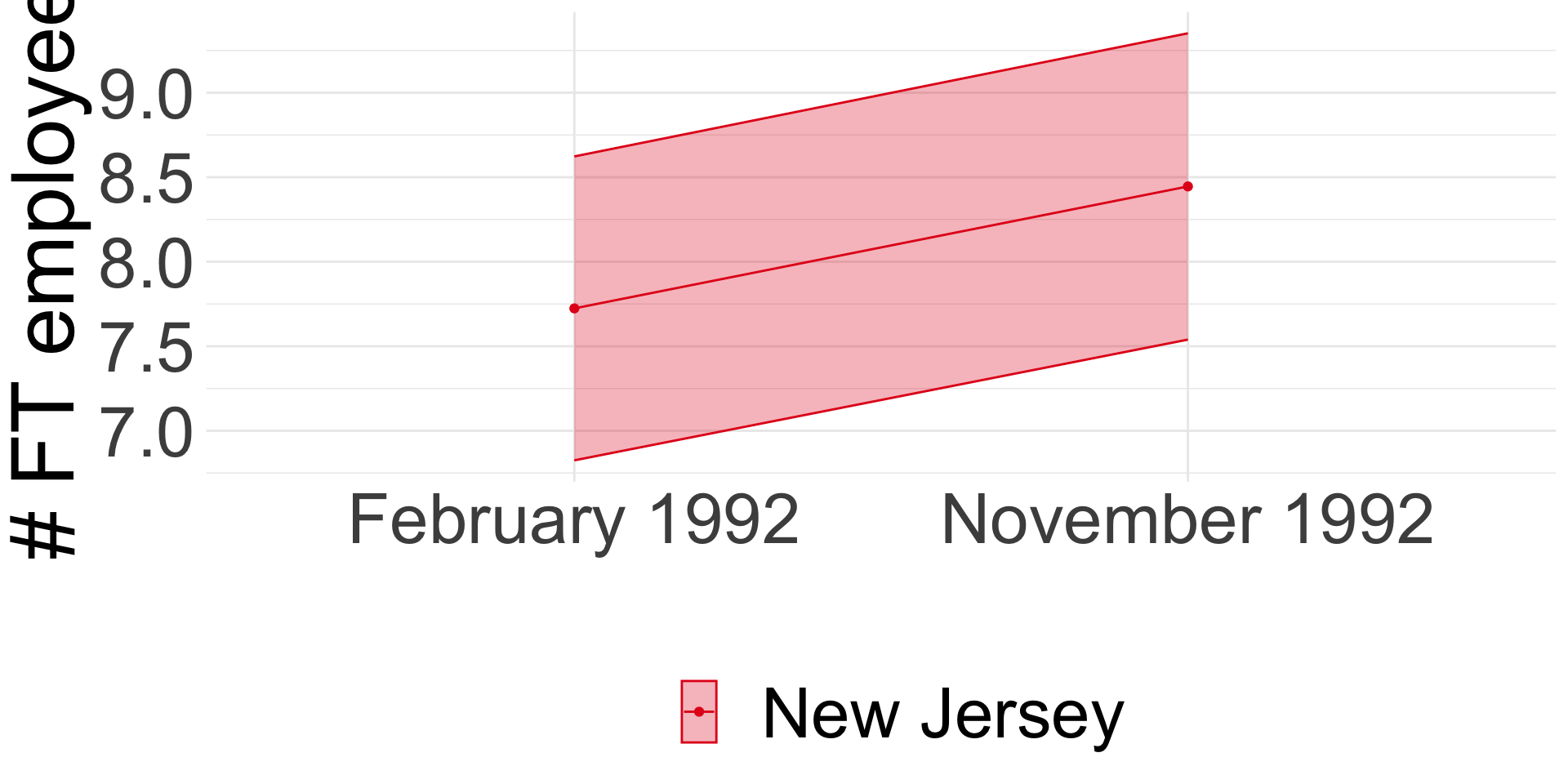
Minimum wage and employment
Card and Krueger (1994): Difference-in-differences
- Compare before and after:
\(E_{t1}^{NJ} - E_{t0}^{NJ}\) = 0.59 (se = 0.54) - Compare NJ and PA:
\(E_{t}^{NJ} - E_{t}^{PA}\) = -2.89 (se = 1.44)

Minimum wage and employment
Card and Krueger (1994): Difference-in-differences
- Compare before and after:
\(E_{t1}^{NJ} - E_{t0}^{NJ}\) = 0.59 (se = 0.54) - Compare NJ and PA:
\(E_{t}^{NJ} - E_{t}^{PA}\) = -2.89 (se = 1.44) - Diff-in-diff:
\(\left(E_{t1}^{NJ} - E_{t0}^{NJ}\right) - \left(E_{t1}^{PA} - E_{t0}^{PA}\right)\) = 2.75 (se = 1.34)
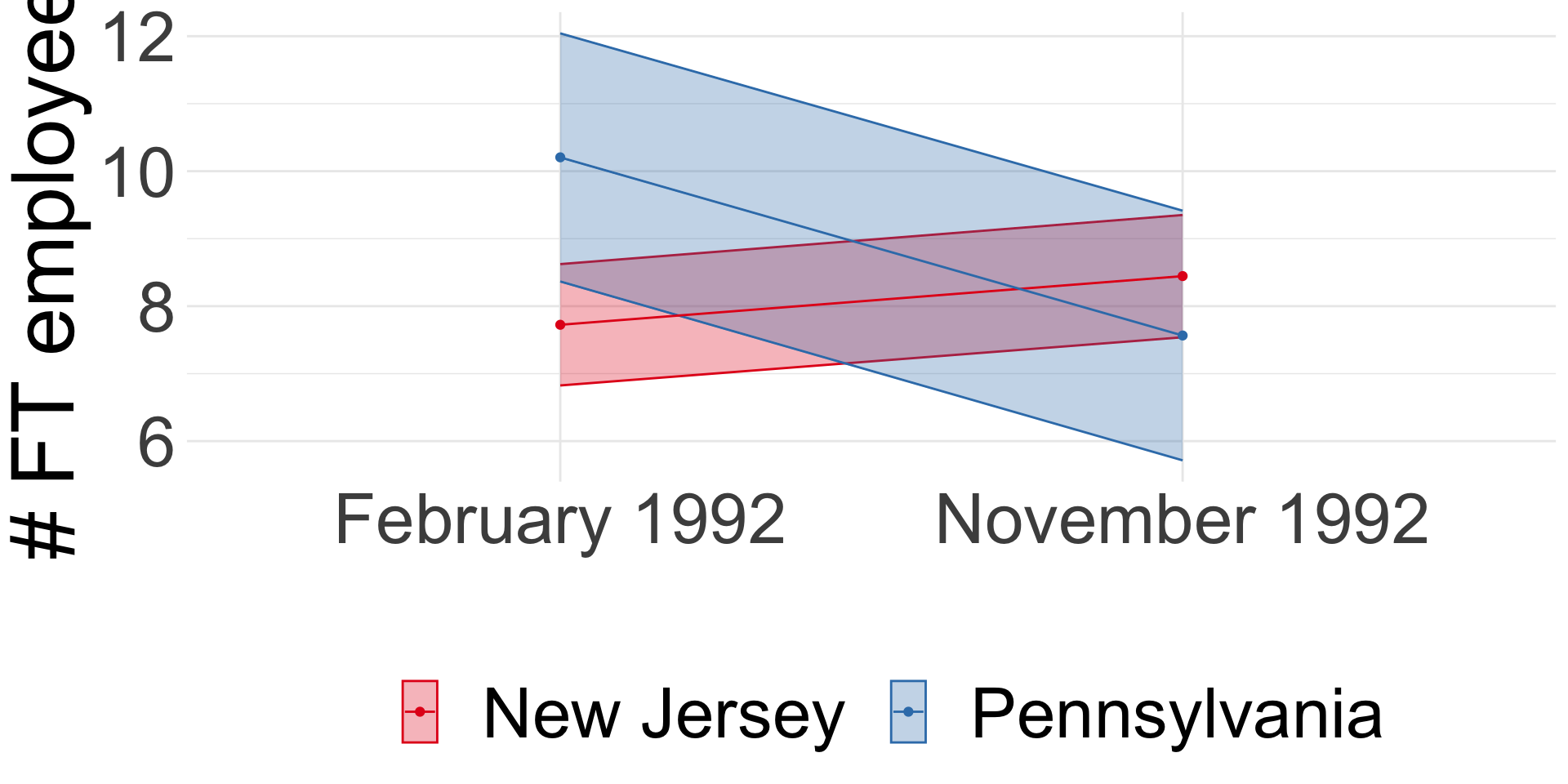
STILL ongoing research field! next more recent paper with opposite conclusion
Minimum wage and employment
Jardim et al. (2022)
Seattle \(\uparrow\) min wage from $9.47 up to
- $11 in April 2015
- $13 in January 2016
Causal design:
- synthetic control: weighted average of other counties that match pre-Seattle
- nearest neighbour matching: find “closest” worker outside of Seattle matching treated worker in Seattle
Minimum wage and employment
Jardim et al. (2022): synthetic control
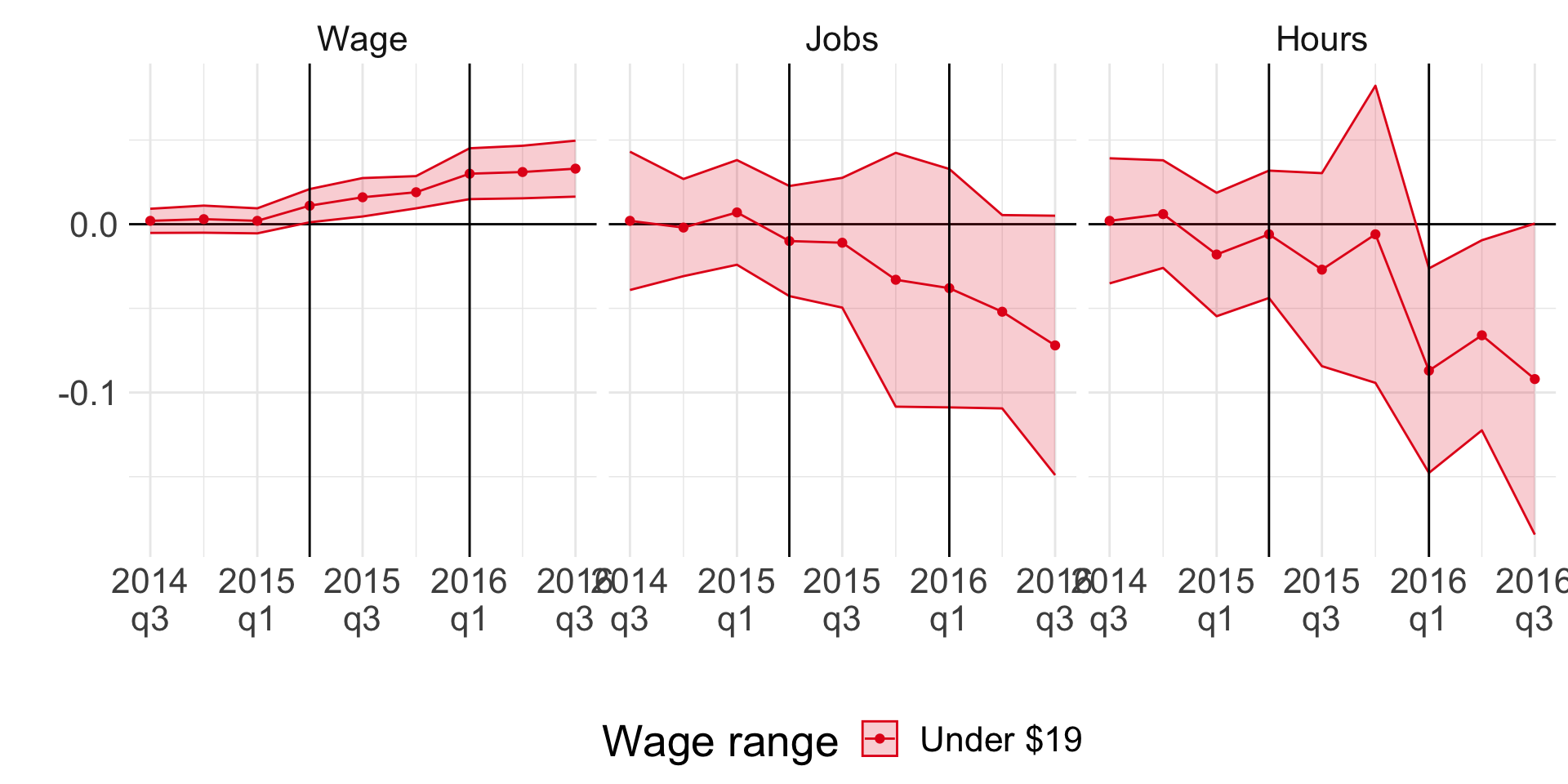
Vertical lines show two episodes of min wage hikes
Visible increase in observed wages
Negative (but zero) effect on employment
Negative effect on hours!
This is in the segment of the labour market affected by min wages.
What can we expect about results in other segments of the labour market?
Minimum wage and employment
Jardim et al. (2022): synthetic control

Discuss on next slide!
Cascading effect on wages!
Also positive effect on hours and employment!
Probably general equilibrium at play?
Other issues:
excluded employers with multiple locations that are believed to employ some 40 percent of Seattle’s low-wage earners.
So, mom-and-pop retailers were counted, but McDonald’s franchises and the like were not!
Some may argue that McDonald’s less elastic compared to mom-and-pop retailers => significant negative effects
Minimum wage and employment
Jardim et al. (2022)
- Negative effect on hours worked stronger than on employment
- Experienced workers are better off
However,
- Potentially cascading effect
- Excluded large low-wage employers (like McDonald’s) (monopsony)
Reich, Allegretto, and Goddy (2017)
same policy + synthetic control = no change in employment
Short informal overview in https://anderson-review.ucla.edu/minimum-wage-primer-leamer/
Bridge to next slide:
Basic models say \(L \downarrow\) when min wage \(\uparrow\). What can explain opposite finding?
Minimum wage and employment
Monopsony

Another model: heterogeneous labour supply (skilled vs unskilled) see Cahuc (2004)
Alternative: basic models only have employment margin. In reality, many other margins for how firms might respond.
Minimum wage and other margins
Review in Clemens (2021)
- Price pass-through (Leung 2021; Renkin, Montialoux, and Siegenthaler 2022)
- Non-wage labour cost (Clemens, Kahn, and Meer 2018)
- Flexibility (theoretical Clemens and Strain 2020)
- Effort (Ku 2022; Coviello, Deserranno, and Persico 2022)
- Firm profit (Draca, Machin, and Van Reenen 2011; Bell and Machin 2018)
- Firm exit (Luca and Luca 2019; Dustmann et al. 2022)
Summary
Basic static and dynamic models of labour demand
Application to minimum wage policy
- Ongoing research (little consensus)
- Clear that basic models are insufficient
- Typical frameworks: heterogeneous labour, monopsony
- Non-wage margins important and can interact with labour supply
Next: Human Capital
